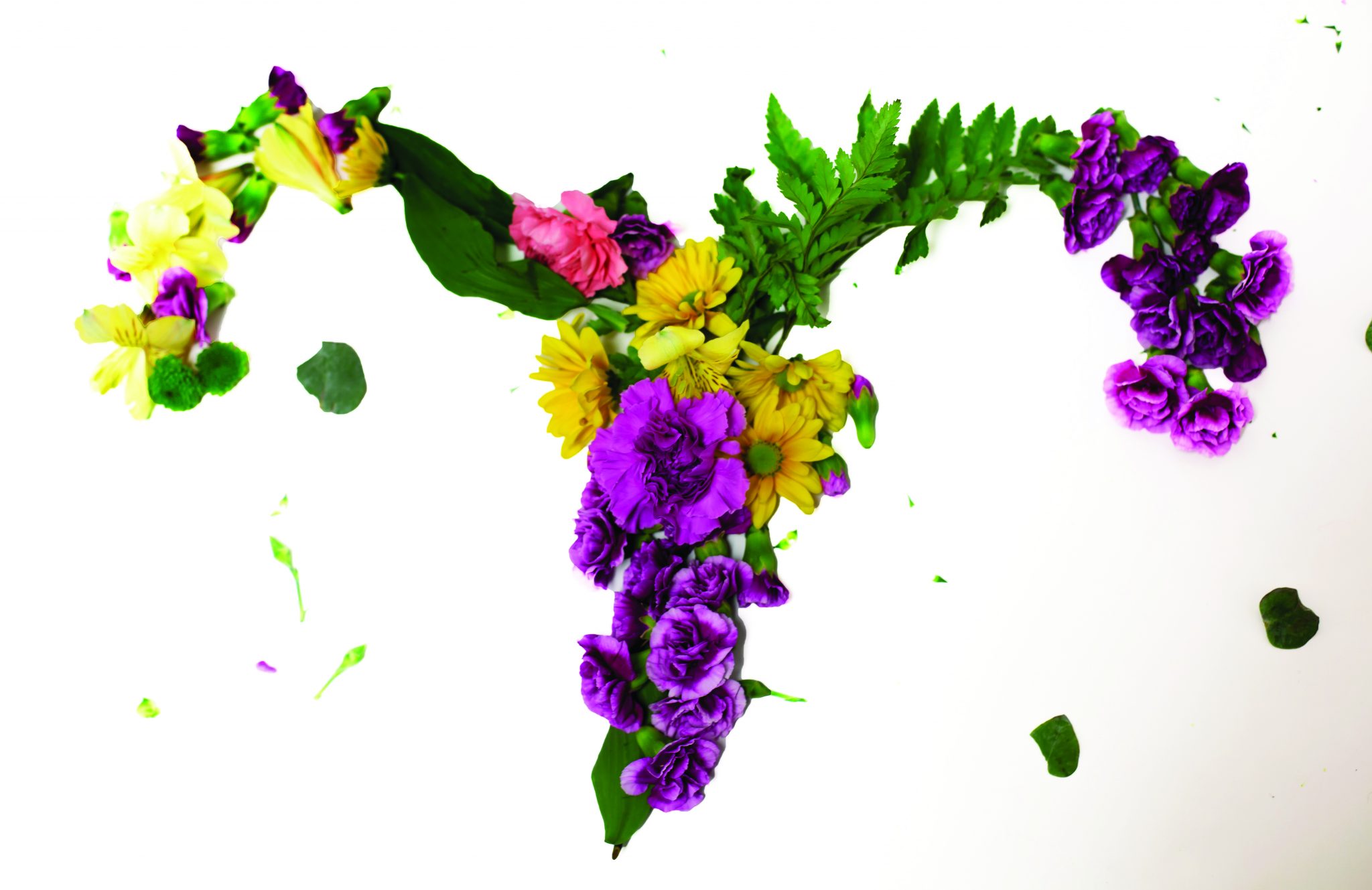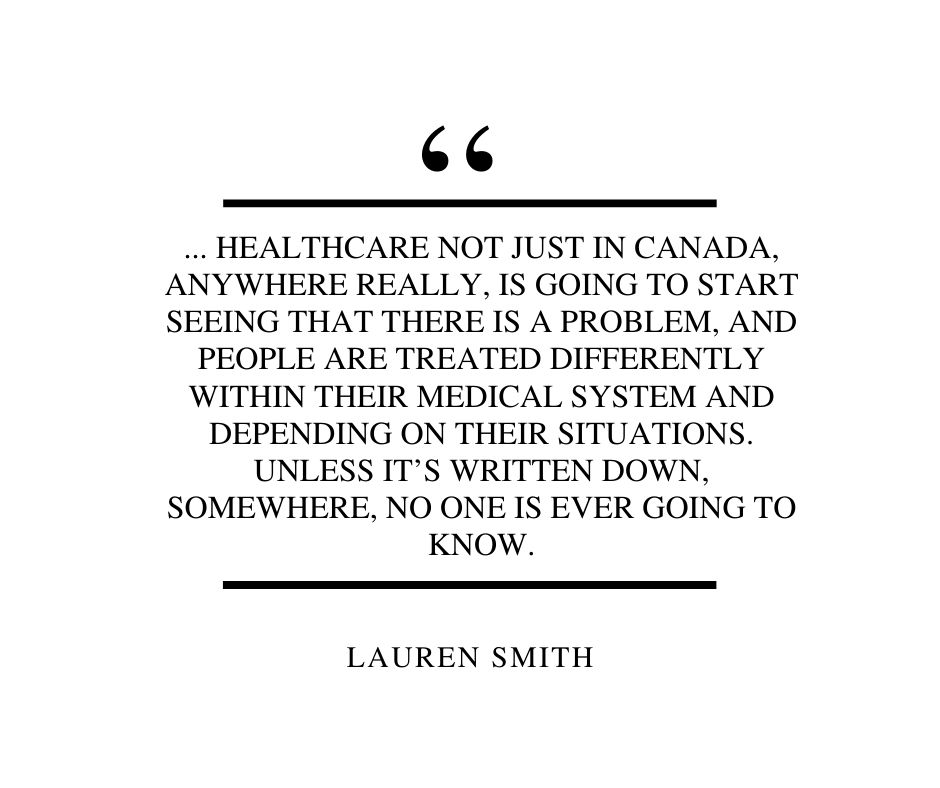Finding answers: the debilitating journey of women who seek solutions for their pain

“We were all just too sensitive. Fatigue too thick to make sense of phone, Trader Joe’s, Laundromat, let alone meeting, party, dance floor. We go away. Sick.” — Dirty River Girl [Bodymap], Leah Lakshmi Piepzna-Samarasinha

Standing in the line at Starbucks, I feel it. It creeps up on me — slowly at first. As the list of drinks on the menu blurs together into one, the pain spreads like shattered glass on the floor of my abdomen and into my spine. I stumble outside, breathless. I call my boyfriend, in a haze of pain, fear and nausea. He calms me as I stagger home, collapse onto my bed, thumb the lid off my orange pill bottle and close my eyes, waiting for it to be over.
When I was in grade ten, I started to experience extreme bouts of pain. My periods became insufferable, and the discomfort and extremely unpleasant symptoms that would accompany it would last for days, and eventually weeks at a time with little to no relief.
I was pin-balled from specialist to specialist without a clear explanation for my symptoms, and I sat in the waiting areas of emergency rooms over a dozen times throughout and after high school. Each time I went in, I thought that something must have been severely wrong with me if it was causing me so much pain.
My mother tirelessly exhausted every possible resource and did everything she could to help me find a solution to fix what was wrong with me. I had to take a leave from school — something that caused my mental health to suffer and deteriorate significantly — and I could never give a clear answer to my friends, my teachers or my professors when they asked what was going on or I had to explain an absence.
I didn’t necessarily look sick from the outside, and I hid the reality and the extent of my symptoms whenever someone would come over to visit me. They didn’t see me lying doubled over on my bed, crying with a heating pad pressed against me or sitting wide awake in the middle of the night, not able to sleep, because I felt so violently ill.
When I listed off my symptoms to different doctors, each time sounding more and more worn down, like a tape that had been replayed a few too many times, they gave me a variety of “simple” reasons — lack of sleep, stress, possible irritable bowel syndrome — as to why I was feeling so rotten or, more frequently, no definite answer at all.
One male gynaecologist interrupted me while I was speaking, told me I had a “nervous vagina” and said that I just needed to take different birth control pills — a common prescription for problematic periods, but a suggestion that turned out to be merely the “no-name” brand of the same pill I was already taking.
While another gynaecologist I saw didn’t physically examine me at all, brushed me off and explained, essentially, that I needed to toughen up and carry on with my life — to not let whatever pain I was dealing with “win.”
After over nine years that included visits to countless medical professionals, endless tests and a continuing myriad of symptoms, I finally received a diagnosis from a doctor that seemed to fit what I always had suspicions of having — endometriosis.
While it affects everyone who has it differently, it’s a condition where tissue that’s similar to the lining of the uterus, that’s “endometrium-like,” is found growing outside of the uterus on other parts of the body — it can cause chronic pain, depression, heavy periods and infertility.
Despite an estimated one in 10 people living with endometriosis across the country, according to the Canadian Society for the Advancement of Gynecologic Excellence, lack of extensive research and medical provider knowledge result in inadequate treatment options and diagnoses that can take up to seven years.
In a recent study done by the BBC, more than 13,500 women shared their experience living with endometriosis — the largest study of its kind surrounding the condition. Roughly half of those women revealed that they developed suicidal thoughts because of it.
My experience is by no means unique, and it speaks to a common thread that ties women’s health struggles, specifically regarding gynecological ailments, together; being disbelieved, invalidated or ignored entirely, with no explicit solution given for months, years or, in some cases, ever.
Oscar winner and acclaimed actress Susan Sarandon has said that she suffered from the condition for years, “thinking of myself as someone who was weak and somewhat hysterical” — a frequent feeling shared amongst endometriosis sufferers and women with seemingly unsolvable health concerns.
As Abby Norman highlights in her novel, Ask Me About My Uterus, “The medicalization of female internal sensations, which began as early as the 1800s, paved the way for the struggles modern women face in having their symptoms taken seriously in a medical setting.”
It’s unsurprising that this was the case, given that “hysteria” was used as a blanket diagnosis for numerous symptoms women would experience until the twentieth century.
In the early 1900s, my great grandmother Olive gave birth to nine children, two of whom died after birth. She had several miscarriages, was extremely ill for the beginning of my grandfather’s life, and died from bleeding complications while she was pregnant with her tenth child.
This was during a time where little was understood or known about women’s health, and it certainly wasn’t something that was discussed or addressed openly.
As a teenager in the 1970s, my mother had horrendous periods every two to three weeks. Her male doctor told her that there was nothing that could be done to help her.
And, after struggling with the same symptoms well into her adult life that caused her to have difficulty getting pregnant with me, she received an endometrial ablation to treat her endometriosis (the eventual diagnosis she received) and was unable to have any more children because of it.
My aunt Judy had only lived with light periods until she suddenly experienced excessive bleeding and pain as a middle-aged adult. After repeated visits to her family physician who reassured her that she only had pre-menopausal symptoms — without ever running any tests to confirm this — she saw her husband’s doctor two years later.
She was immediately referred to a gynaecologist and underwent an urgent biopsy where she was diagnosed with endometrial cancer. Shortly after receiving a hysterectomy, she was in severe pain, and it was found that the cancer had already spread to her tailbone and spine.
Judy died a year later, at the age of 52. If the cancer had been caught when her symptoms began, she could have had between a 75-88 per cent chance at surviving, based on the current statistics surrounding endometrial cancer treatment and mortality rates.
After suffering from a list of unbearable symptoms and being disbelieved by medical professionals for years, Saturday Night Live comedian Gilda Radner was diagnosed with ovarian cancer. Her husband, Gene Wilder, recalled, “Gilda cried, but then she turned to me and said, ‘’Thank God, finally someone believes me!’’

What Norman describes as “a quest to make doctors believe in women’s pain,” has been an ongoing pursuit and something that continues to impact women today.
Stacey Jacobs, the sexual health education manager at Sexual Health Options, Resources & Education (SHORE Centre) and a teacher in the Sexuality, Marriage and Family Studies Program at the University of Waterloo, has endometriosis herself and is well-versed in what it means to live with the disease.
“I’ve also been to lots of doctors over the years, and some are great and some suck. I had a man when I think I was about 21-22 [years-old], tell me ‘you have endometriosis.’ I did not know what that was, it was this huge word thrown out there that no one talked about at that time, and I just kind of looked at him and he said, ‘that pretty much means that you can’t have babies, so if you want one, you better hop to it.’ And he walked out of the room,” Jacobs said.
Finding long-term solutions for conditions like endometriosis and their symptoms can be notoriously challenging, and it’s never certain or determined what will work for each person who may have it.
“[With] physicians, they’ll usually just put someone on hormonal birth control to try to regulate their cycles. So, then someone can be on that hormonal birth control, from puberty until who knows when. It’s not a solution, it’s just kind of like one of those band-aid ideas. But it can help a lot of people with their pain specifically, it can help with heavy bleeding, and you do want to suppress those cycles sometimes because if you can’t get rid of that tissue, it’s just going to grow and cause more problems,” Jacobs said.
“So, as someone with endometriosis, I know that when I go off hormonal birth control, bad things have happened inside my body. The one time I went off birth control, [the tissue] grew into my bladder and I had to have bladder surgery; one time it grew around the ureter, and attached to my kidney … I’ve had about four surgeries now. A lot of people end up having surgeries, which often ends up causing more problems … with all of the scar tissue, and moving things around.”
Jacobs is a strong advocate for sexual health education and believes that part of improving the treatment for it is incorporating more information about potential conditions like endometriosis into the teaching and instruction that SHORE does, especially with youth and teens.
“Letting people know, that a lot of us are just told ‘it’s your period, that it’s normal’, and just because something is common, [because it] happens to a lot of people, doesn’t mean that it’s normal and that it should be happening and that we shouldn’t bother to do anything about it,” Jacobs said.
“There are so many people who are suffering through this, and let’s say they’re 12, 13, 14, 15 [years-old] … why should you have to be taking those days off school because you have your period and you’re in so much pain that you can’t go? And sometimes people don’t believe you — so it’s letting people know that’s not okay.”
Jacobs also believes that acknowledging the variety of ways people experience endometriosis is key in understanding it and being compassionate about it. 
“There [are] so many symptoms that can come with endometriosis, as well. I’ve also learned not to just talk about my symptoms because those may not be the same symptoms that somebody else has. A lot of people have pain with sex [or] pain in different parts of their bodies as well,” Jacobs said.

For someone like Lauren Smith*, who is a member of the LGBTQ+ community, her endometriosis diagnosis proved to be challenging. As a newcomer to Canada, Smith visited a drop-in doctor in Toronto, hoping to receive an answer for her symptoms — but was prescribed a birth control pill with no explanation as to why she needed it.
“He didn’t mention anything about any possible reason, there was no mention of polycystic ovaries, endometriosis, not a single thing, just the same thing doctors have been saying over and over again, which is: ‘cramps hurt, some women’s periods are just like that, some people’s are heavier than others’ — there was no real concern that there was anything other than a regular period,” Smith said.
To complicate matters further, when Smith went to receive an internal ultrasound in 2016, the technician persistently asked if she was a “virgin.”
“But she kept going on, and I was not going to tell [her] that I’m a virgin, but I can tell you this: I have never had sex with a man. And she said, legislatively, we can’t do this procedure on you. I didn’t really know what else to say at the time — she was very dismissive. I was shocked, but a little part of me thought that maybe it was legislation. I don’t know, I’m not a medical professional,” Smith said.
“I thought the doctor would tell me otherwise when I went back to see him, but he was not concerned in the slightest, just [mentioned] the external ultrasound … I’m sure everything is fine. Then what is the point of an internal one at all? I don’t know … He couldn’t have cared less, was not interested, so I left and didn’t do anything about it for another two years, because I couldn’t really find a GP that I liked [and] would listen to me about anything.”
After going to the Hassle-Free Clinic — an LGBTQ+-friendly clinic, where the doctors are female — Smith was able to receive a proper diagnosis and clarity about being denied an internal ultrasound.
“So when I asked her, she was like ‘absolutely not, no, that is not legislation: anyone can have one. If they want to ask you that question — which I don’t know why they would — but if they want to ask you that question, it’s maybe just to warn you afterwards that it might be painful, and if so, just let [them] know and [they] can stop. That’s the only reason they should be asking.’
“She then explained to me, for the first time, anything about endometriosis and what it means. She almost immediately said that she would suspect that’s what’s going on. But because I don’t want children, she said the main reason people seek for at least a temporary reprieve from endometriosis is to conceive,” Smith said.
Smith returned to the same clinic she went to previously to receive another ultrasound and was denied, once again, on the pretense that she was a virgin.
“I’ve even been contacting clinics asking them why they’re writing that on their websites: because there’s a lot of clinics that even say on their websites that ‘if you’re a virgin, you can’t have this procedure’. Which, I’m now on this other weird crusade of, why is anyone in the medical profession using that word at all, because I don’t even understand what they think it means? So, someone’s a virgin unless they’ve slept with a man, that is what we’re still thinking, apparently? I just don’t think that word should be used, at all, in medicine … because what is it, about having sex with a man, that would do to my anatomy that you think it’s missing? Because I could be doing all of those things without a man — you do realize that right?” Smith said.
Smith’s experience is what sparked her inspiration to create “QueerHellth” a website and safe space for people in the LGBTQ+ community to share their healthcare stories.
“The idea behind it was twofold: so that people would have a place to tell their story without putting their name to it … that way it can just be completely anonymous; and then I thought it would be helpful if other people could search these stories to then see ‘oh, that’s happening to me right now, and that’s how you dealt with it — maybe that could work for me’ … the other reason, I’m hoping, that if it gains a bit of momentum and we have story after story, healthcare not just in Canada, anywhere really, is going to start seeing that there is a problem, and people are treated differently within their medical system and depending on their situations. Unless it’s written down, somewhere, no one is ever going to know,” Smith said.
Prioritizing the plights of women and marginalized communities who seek to find answers to their pain is something that will continue to be relevant until more progress is made towards accessible treatment, understanding and education.

There’s a concept called “spoon theory” that is often used as a metaphor for people with disabilities and chronic pain. Spoons are used as a visual representation in order to quantify how much energy a person has during the day. Each activity requires a given number of spoons, which will only be replaced if a person rests in order to recharge. Someone who runs out of spoons has no choice but to rest until their spoons are replenished.
For some people, all, or most, of those spoons are used before a day is done or even begins.
And for those living with the pain related to gynaecological related illnesses, our spoons have to be measured carefully in order to get through each day with enough energy and comfort to finish it.
Though my journey with this disease remains ongoing, I’m lucky to have finally found someone who was willing to listen to me.
As actress and comedian Whoopi Goldberg, who was diagnosed with endometriosis over 40 years ago, said at the Endometriosis Foundation’s Blossom Ball in 2009: “Because if you don’t discuss it, many more women are going to find themselves unable to have children, or find themselves close to dying because [the disease has] led to something else.”

*This individual’s name has been changed to protect the privacy of the parties involved.


